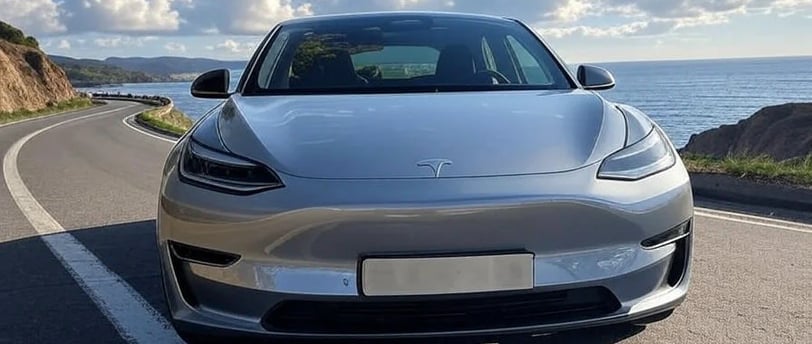Review Article: Electric Vehicle Impact on the Environment - A Case Study
Naim Sheikh
5/29/20255 min read


Electric vehicles (EVs) are often hailed as a cornerstone of sustainable transportation, promising reduced greenhouse gas (GHG) emissions compared to internal combustion engine (ICE) vehicles. However, the environmental benefits of EVs depend heavily on the source of their electric energy. A 2023 research paper by Pawel Albrechtowicz, published in Energy Reports (Volume 9, pp. 3813–3821), titled "Electric vehicle impact on the environment in terms of the electric energy source - Case study", dives deep into this topic, examining the emissions profile of EVs in Poland. This review explores the paper’s key findings, methodology, and implications for the future of EVs, offering insights for eco-conscious consumers, policymakers, and researchers.
Overview of the Study
Albrechtowicz’s study challenges the notion that EVs are inherently "zero-emission" vehicles by analyzing the real-world emissions associated with their electricity consumption in Poland, where the energy mix is heavily reliant on fossil fuels. The research compares GHG emissions from EVs to those from ICE vehicles, factoring in power system losses and the Polish energy grid’s characteristics. The study is particularly relevant for regions with coal-dominated energy systems, as it highlights how energy source composition impacts EV sustainability.
Key Objectives
Evaluate Emissions: Calculate the GHG emissions from EVs based on Poland’s fossil fuel-heavy energy mix.
Compare with ICE Vehicles: Assess how EV emissions stack up against ICE vehicles under Euro 4 and Euro 6 standards.
Analyze Power System Efficiency: Account for energy losses in Poland’s transmission and distribution systems in rural and urban areas.
Explore Renewable Energy Potential: Highlight the role of renewable energy sources (RES) in reducing EV-related emissions.
Methodology and Data
The study adopts a straightforward methodology to assess the environmental impact of EVs, avoiding complex predictive models. Instead, it uses real-world data from official Polish reports and industry standards. The key steps include:
Collecting GHG Data: The study gathers average GHG emissions for Poland’s power generation mix, including coal, lignite, gas, and renewable sources.
Energy Consumption Analysis: It calculates energy consumption for medium-sized EVs (15–22 kWh per 100 km) and ICE vehicles (6–8 liters per 100 km).
Distribution System Parameters: The research distinguishes between rural areas (RA) and urban areas (UA), analyzing power losses in medium voltage (MV) and low voltage (LV) lines and transformers of varying capacities (20–800 kVA).
Charger Efficiency: Four charging scenarios are evaluated: slow single-phase (3.7 kW), fast single-phase (7.4 kW), slow three-phase (11 kW), and fast three-phase (22 kW).
Emission Comparisons: Emissions from EVs are compared to ICE vehicles under Euro 4 and Euro 6 standards.
The study leverages data from credible sources, such as the Polish transmission system operator (PSE S.A.), the National Centre for Emissions Management (KOBiZE), and industry reports. For example, it cites the 2021 energy mix, where 80% of Poland’s electricity came from coal (see Figure 3 in the paper).
Polish Energy Mix 2021
markdown
Show inline
Key Findings
1. EVs Are Not Zero-Emission in Fossil Fuel-Heavy Grids
The study reveals that EVs in Poland generate significant GHG emissions due to the country’s coal-dominated energy mix. For a 100 km drive, EV emissions range from 18.6–25.8 kg of CO₂, depending on the charger type and distribution system (rural vs. urban). In contrast, ICE vehicles under Euro 4 standards emit approximately 12 kg of CO₂, while Euro 6 vehicles emit 9.5 kg (Table 4). This suggests that in some scenarios, EVs may produce more CO₂ than modern ICE vehicles.
2. Power Losses Impact Efficiency
Energy losses in Poland’s transmission and distribution systems significantly affect EV efficiency. Rural areas, with longer overhead lines and smaller transformers (e.g., 20 kVA), experience higher losses compared to urban areas with modern cable lines and larger transformers (e.g., 400 kVA). The study estimates total system efficiency at 88–90%, with rural areas on the lower end due to longer transmission distances (see Figure 8).
3. Charger Type Matters
The type of charger influences both energy consumption and emissions. Single-phase slow chargers (3.7 kW) result in slightly higher emissions (e.g., 24.581 kg CO₂ in rural areas with a 20 kVA transformer) compared to fast three-phase chargers (22 kW), which are more efficient (Table 5 and Table 6). However, the difference is marginal, emphasizing that the energy source is a more critical factor than charger efficiency.
4. Renewable Energy as a Game-Changer
The study underscores the potential of renewable energy sources (RES) to make EVs truly low-emission. Poland has seen significant growth in micro-installations (e.g., rooftop solar PV), with total power rising from 30 MW in 2016 to 6071 MW in 2022 (Table 1). Expanding RES, such as offshore wind farms and home PV systems, could drastically reduce EV-related GHG emissions.
Micro-Installations Growth in Poland
markdown
Show inline
Implications for EV Adoption
Albrechtowicz’s findings have significant implications for EV adoption, particularly in coal-reliant countries like Poland:
Energy Mix Transition: To achieve the environmental benefits of EVs, Poland must accelerate its shift toward renewable energy. Offshore wind farms and prosumer installations (e.g., home PV) are promising solutions.
Infrastructure Upgrades: Modernizing rural distribution systems, with shorter lines and higher-capacity transformers, could reduce energy losses and lower EV emissions.
Policy Considerations: Policymakers should incentivize renewable energy adoption and coordinate EV charging to minimize grid strain and voltage variations.
Consumer Awareness: EV buyers in fossil fuel-heavy regions should be aware that their vehicles may not be as eco-friendly as advertised unless paired with clean energy sources.
Strengths and Limitations
Strengths
Data-Driven Approach: The study uses real-world data from Polish authorities, ensuring reliability.
Comprehensive Analysis: It accounts for multiple variables, including charger types, distribution systems, and Euro standards.
Practical Insights: The focus on typical rural and urban scenarios makes the findings applicable to real-world conditions.
Limitations
Poland-Specific Focus: The results are tailored to Poland’s energy mix and grid infrastructure, limiting generalizability to countries with cleaner energy systems (e.g., Norway or Sweden).
Simplified Models: The study avoids predictive modeling, which could provide deeper insights into future trends.
Omitted Variables: Factors like driver behavior and vehicle maintenance, which affect real-world consumption, are not fully explored.
Conclusion
Albrechtowicz’s study is a critical reminder that the environmental benefits of EVs are not guaranteed—they depend heavily on the electricity source and grid efficiency. In Poland, where coal dominates the energy mix, EVs can produce higher GHG emissions than modern ICE vehicles. However, the rapid growth of renewable energy sources offers hope for a greener future. For eco-conscious consumers, pairing EVs with home solar panels or advocating for cleaner national grids is essential. For researchers and policymakers, this study highlights the need for holistic approaches to transportation sustainability, combining EV adoption with renewable energy expansion and grid modernization.
References
Albrechtowicz, P. (2023). Electric vehicle impact on the environment in terms of the electric energy source - Case study. Energy Reports, 9, 3813–3821. https://doi.org/10.1016/j.egyr.2023.02.077
Agencja Rynku Energii, S.A. (2021). EMITOR 2020 Emisja zanieczyszczeń środowiska w elektrowniach i elektrociepłowniach zawodowych.
Czyzak, P., & Wrona, P. (2021). [Source for distribution system parameters].
Jochem, P., Babrowski, S., & Fichtner, W. (2015). Assessing CO₂ emissions of electric vehicles. Transportation Research Part A: Policy and Practice, 78, 101–114.
Kubiak-Wójcicka, K., et al. (2022). [Source for water energy and EV supply].
Moro, A., & Lonza, L. (2018). [Source for cleaner energy and EV predominance].
PTPIREE (2021). [Source for micro-installations data].
